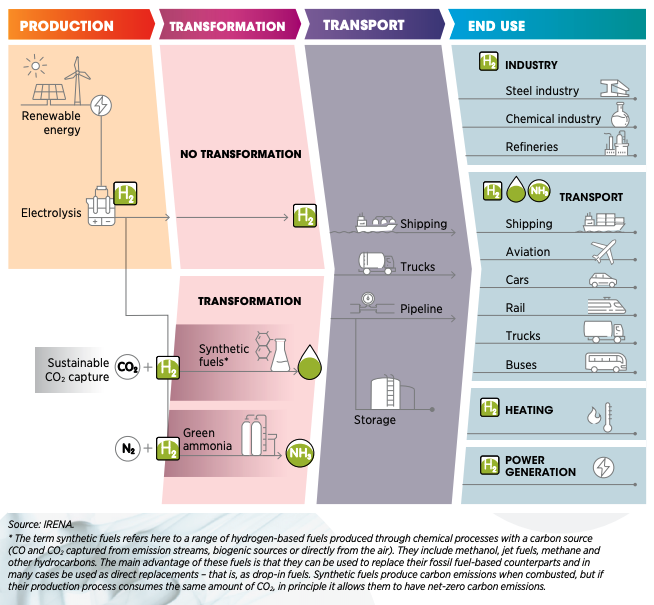Green hydrogen has been an expensive fuel, so far. Producing it by solar or wind energy (and electrolysis) is now three to four times as expensive as producing ‘grey’ hydrogen from natural gas, releasing CO2. And there are the technical problems surrounding hydrogen handling. Yet, some people believe that green hydrogen will be the fuel of the future.

Many technologies
Many colours surround the advent of hydrogen technologies, like Iek de Pagter wrote on this site: black, grey, green, blue, turquoise, purple, aquamarine, and more. They denote different ways of producing the substance. Iek made a strong plea for ‘flash hydrogen’: hydrogen produced by plasmolysis; the process in which gases are guided through a continuous ‘arc’ that is maintained between two electrodes. Such gases decompose into the elements. Under the right reaction conditions, 100% of methane splits into hydrogen and carbon. The carbon can either be used as ‘carbon black’, or stored. Where it will do much less harm, compared to when it would be released into the atmosphere as CO2.
Uncertainties abound when looking into the future for hydrogen. Like ‘the future evolution of demand, the lack of clarity about certification and regulation and the lack of infrastructure available to deliver hydrogen to end users.’ Demand for hydrogen keeps on growing, but just in traditional sectors where it was used already. New applications like in heavy industry (for instance, steel production) and long-distance heavy transport do not take off. In other words, infrastructural projects are not in the pipeline. Whereas, for the IEA for instance, this would be essential in the realization of its Net Zero Emissions scenario.
New energy technologies
The world is looking for new clean energy technologies. Making use of hydrogen may be one of them. However, the production technology of hydrogen matters a lot. So far, green hydrogen and the flash hydrogen just mentioned are the only types produced in a climate-neutral manner; essential for reaching net zero by 2050. And there is potential in hydrogen. Hydrogen is emerging as one of the leading options for storing energy from renewables. Moreover, hydrogen or hydrogen-based fuels can potentially transport energy from renewables over long distances. To store and to transport energy – these matter in our energy future.
In fact, hydrogen holds so many possible promises for our energy future, that many institutes and companies research its applications. We will mention a few. One of these companies is the Spanish company Acciona, ‘business as unusual’. They acknowledge that green hydrogen is more expensive than grey hydrogen (produced together with CO2 from natural gas). However, as they say, renewable energies fall in price quickly. This opens up a new window of opportunity. ‘Solar electricity is 10 times cheaper than it was a decade ago and wind energy costs less than half.’ Consequently, the price of the electricity needed for the electrolysis is reduced as well. Green hydrogen, they hold, is the ‘key energy vector for achieving global decarbonisation’. Nevertheless, they concede that very large investments will have to be made until 2050 in order for this avenue to become real.

A fundamental shift
Another company is the Danish Green Hydrogen Systems, ‘a leading provider of standardised, modular electrolysis equipment for the production of green hydrogen solely based on renewable energy’. As they say, ‘green hydrogen provides the critical link between renewable electricity generation and hard-to-abate sectors such as industry, heavy transport and buildings. With its wide range of possible applications, green hydrogen plays a key role in the ongoing fundamental shift in our energy systems towards a net-zero emission society in 2050.’ They build machines for an on-site supply of green hydrogen.
The Dutch company Avoxt develops electrolysers without membranes. These can produce green hydrogen faster and cheaper. At a price eventually equal to that of ‘grey’ hydrogen. The company is located at the high-tech campus in Eindhoven. It’s pilot installation now produces 100 W of green hydrogen; next year that should be 200 kW, but the eventual goal will be in the order of MWs. But, as they say, at times green electricity will be free: on sunny and windy days. Then, an electrolyser located near a solar or wind park will be able to produce very cheap hydrogen. Possible customers will be chemical industry and public gas companies. In the future, transport may be based on green hydrogen: lorries and trucks, buses, trains. Maybe even aeroplanes.
Green hydrogen, a critical enabler
In sum, as the international business organization World Economic Forum writes, ‘green hydrogen could be a critical enabler of the global transition to sustainable energy and net zero emissions economies. There is unprecedented momentum around the world to fulfil hydrogen’s longstanding potential as a clean energy solution. The time is right to tap into hydrogen’s potential to play a key role in tackling critical energy challenges.’
As Dr Emanuele Taibi, Head of the Power Sector Transformation Strategies, International Renewable Energy Agency (IRENA), says: ‘Green hydrogen is an important piece of the energy transition.’ First, we need to accelerate the use of renewable electricity and then ‘decarbonize sectors that are difficult to electrify – like heavy industry, shipping and aviation – through green hydrogen.’
In short: we still need to reduce the price of green hydrogen. If that doesn’t happen, the future of hydrogen in the energy system is still in limbo. Will anyone develop flash hydrogen, like Iek de Pagter proposed?
Author
Diederik van der Hoeven
Source
Supplier
ACCIONA Infrastructure
AVOXT
Green Hydrogen Systems
IEA Bioenergy
International Renewable Energy Agency (IRENA)
Ministry of Road Transport & Highways
World Economic Forum
Share
Renewable Carbon News – Daily Newsletter
Subscribe to our daily email newsletter – the world's leading newsletter on renewable materials and chemicals














